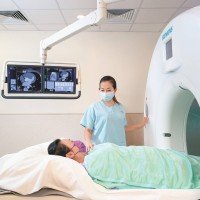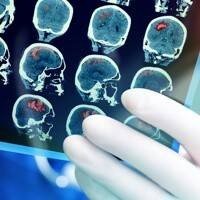Current Statistics
One out of every 14 females in Hong Kong will develop breast cancer during her lifetime. In 2018, 51 percent of women diagnosed with breast cancer were aged 40 to 59. The risk of developing breast cancer increases with age, but early detection allows for better treatment results and a high chance of survival.
What is Breast Cancer?
Cancer is the uncontrolled growth of abnormal cells that damage the body’s healthy tissues and can spread to other organs in the body. Breast cancer refers to a malignant tumor that forms in the breast, with a possibility of cancer cells spreading to the entire breast or other parts of the body.
Breast Cancer Symptoms
- A hard lump in the breast or a change in the size or shape of the breast
- A change in skin texture of the breast or nipple such as dimpling, or appearance of dilated veins
- Newly inverted nipple or bloody discharge from nipple
- Swelling or thickening in the armpit
- Pain in the breast area
Causes
While the causes of breast cancer are still unclear, there are various risk factors associated with the disease, including having a family history of breast cancer. The hospital encourages females to undergo regular breast examinations, including self-exams, clinical breast examinations, and mammograms. This three-pronged approach enables regular monitoring of changes in the breasts and allows for early detection and treatment of breast cancer.
|
Non-Modifiable Risk Factors |
Modifiable Risk Factors |
|
Age |
Not having children or having them after the age of 35 |
|
Family history of breast cancer |
Not breastfeeding |
|
Genetics |
Having received hormone replacement therapy (HRT) |
|
Menstrual history (starting menstruation early or experiencing menopause late) |
Having received chest radiation therapy before age 30 |
|
History of breast cancer |
Being overweight or obese after menopause |
|
History of benign breast disease |
Consumption of alcohol |
|
|
Lack of exercise |
Breast Examination Guidelines (for those without symptoms) + Diagnostic Tests
Those with a family history of breast cancer or other risk factors should consult a doctor.
|
|
Monthly Self-Exam |
Annual Mammogram |
Biennial Mammogram |
|
Women Aged 20-39 |
✓ |
|
|
|
Women Aged 40-49 |
✓ |
✓ |
|
|
Women Aged 50-69 |
✓ |
|
✓ |
Diagnostic Tests
- Clinical exam: A doctor performs a physical examination of the breasts to check for abnormalities, such as lumps or nipple discharge, and decides whether a mammogram or ultrasound is required.
- Mammogram: X-ray images are used to detect any abnormalities in the breast tissue or tumors that are either too small to feel or not fully formed. This test is suitable for early-stage cancers.
- Ultrasound: An ultrasound helps doctors determine a lump’s location, size, and type
- MRI: Used to assess the extent of breast cancer
- Biopsy: After determining the location of the tumor, a doctor may recommend a breast biopsy to retrieve a tissue sample from the tumor for further testing
Breast Cancer Stages + Treatment
|
Stage |
Description |
Five-Year Survival Rate |
|
0 |
Non-invasive cancer; there is no evidence of cancer cells spreading to other tissue |
99% |
|
I |
Invasive cancer with a tumor of up to 2 cm; cancer cells have not yet spread to the lymph nodes |
90% |
|
II |
Invasive cancer with a tumor measuring between 2 and 5 cm; cancer has spread to the lymph nodes |
70% |
|
III |
Advanced invasive cancer with a tumor larger than 5 cm; cancer has spread to the skin and multiple lymph nodes |
40% |
|
IV |
Metastatic cancer |
20% |
Treatment
Treatment for breast cancer and chances of recovery depend on whether the cancer has spread. Based on the type and progression of breast cancer, the doctor will recommend a suitable treatment plan, which may include: surgery, chemotherapy, radiation therapy, targeted therapy, and/or hormone therapy.
- Surgery:
- Breast-Conserving Surgery/Lumpectomy
- If the size of the tumor is small or is located on the periphery of the breast, the doctor will remove the tumor and some of the surrounding breast tissue. This is usually followed by radiation therapy.
- If the size of the tumor is small or is located on the periphery of the breast, the doctor will remove the tumor and some of the surrounding breast tissue. This is usually followed by radiation therapy.
- Mastectomy
- A complete removal of the breast may be required if the breast lump is large, or if cancer cells have spread to other parts of the breast.
- A complete removal of the breast may be required if the breast lump is large, or if cancer cells have spread to other parts of the breast.
- Sentinel Lymph Node Biopsy
- The sentinel lymph node (the first lymph node that cancer cells are most likely to spread to) is removed and examined to determine whether cancer cells are present.
- Breast-Conserving Surgery/Lumpectomy
- Chemotherapy: Using drugs to destroy or control the spread of cancer cells, chemotherapy is often used after surgery to prevent recurrence. A course of chemotherapy typically lasts three to six months.
- Radiation Therapy: Radiation therapy uses ionizing radiation to destroy cancer cells. The radiation makes small breaks in the DNA of cells, which stops them from growing and causes them to die. A course of treatment usually lasts five to six weeks, and is typically used in addition to surgery and chemotherapy to minimize the risk of recurrence and maximize effectiveness of treatment.
- Targeted Therapy: Targeted therapy uses drugs to attack specific types of cancer cells while sparing healthy cells. It is used to boost the effectiveness of chemotherapy, and is often used to treat HER2-positive breast cancer. A course of treatment usually lasts about a year.
- Hormone Therapy: Used for hormone receptor-positive breast cancers, hormone therapy involves taking medications that prevent cancer cell growth by blocking hormones from attaching to cancer cells or reducing the amount of estrogen in the body. This therapy is often used after chemotherapy, and a full course may last up to 10 years.
Rehabilitation
- Physical:
- Upper Arm Exercise: Regular upper arm stretching with an exercise band can help prevent lymphedema after surgery
- Physiotherapy: Surgery or radiation may damage the lymph nodes. Physiotherapy that incorporates exercise and lymphatic drainage may help minimize the risk of lymphedema
- Balanced diet: Adopting a healthy lifestyle helps promote recovery.
- Mental:
- Seek support from your spouse/partner, family members, friends, and support groups
- Maintain regular checkups, return to normal way of life






















